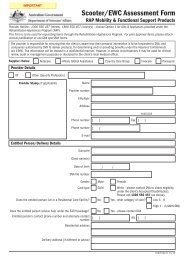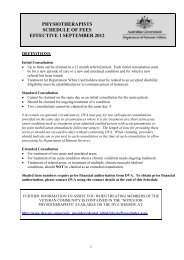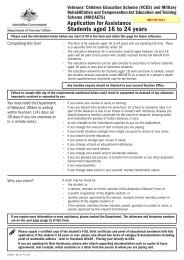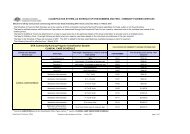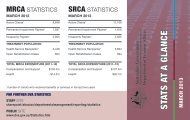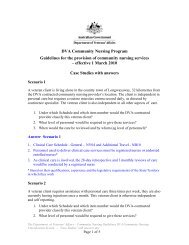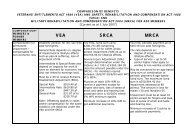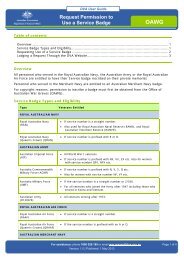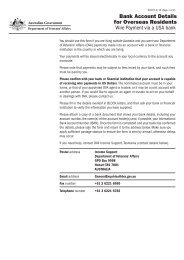SANDAKAN HISTORY DOC - Department of Veterans' Affairs
SANDAKAN HISTORY DOC - Department of Veterans' Affairs
SANDAKAN HISTORY DOC - Department of Veterans' Affairs
You also want an ePaper? Increase the reach of your titles
YUMPU automatically turns print PDFs into web optimized ePapers that Google loves.
42<br />
By the end <strong>of</strong> June there were still some 80 to 90 POWs alive<br />
in what remained <strong>of</strong> the camp. Food now consisted <strong>of</strong> a small<br />
amount <strong>of</strong> rice, some tapioca, coconut oil and scraps smuggled<br />
in to them by some Chinese camp workers. Living quarters<br />
were nothing more than lean-tos made from sticks, blankets<br />
and whatever else came to hand. Most <strong>of</strong> the surviving<br />
evidence <strong>of</strong> life and events at Sandakan in July and August<br />
1945 comes from camp guards interrogated after the war and<br />
Chinese workers. One <strong>of</strong> the latter, Ali Asa, a water boy,<br />
described the camp at this time:<br />
After the truckload <strong>of</strong> men [the 75 taken away on the last march<br />
towards Ranau] had gone all the PW remaining were left in the open<br />
in No 2 Camp site, there were no houses left. These men were sick. About<br />
10 to 12 PW died every day. In August I was ordered by the Japs to<br />
take some ubi kayu [yams] to the PWs, at this time there were only five<br />
alive. They asked me when I was going to bring some food as they had<br />
not had any food for a week.<br />
It was clear that the Japanese now in charge at Sandakan had<br />
no intention <strong>of</strong> allowing any <strong>of</strong> the POWs to survive the war.<br />
On 13 July, 23 men still capable <strong>of</strong> walking were taken out <strong>of</strong><br />
the camp towards the now defunct airstrip. A little later, Wong<br />
Hiong, a young Chinese camp worker, heard shots and when<br />
the guards returned he asked what had happened:<br />
I asked them what they had been shooting and they said ‘ducks’. I asked<br />
how many they shot and they said 23. One <strong>of</strong> the Japs told me that the<br />
23 PW were shot because there were not enough trucks left to take them<br />
away for the march.<br />
Yashitoro Goto, a Japanese guard, later testified to war crimes<br />
investigators about this ‘duck’ shooting:<br />
It was Takakua’s [Captain Takakuwa Takuo] order so we could not<br />
disobey. It would be a disgrace to my parents so we carried out the<br />
orders. Taking the PWs to the airport near the old house on the drome,



